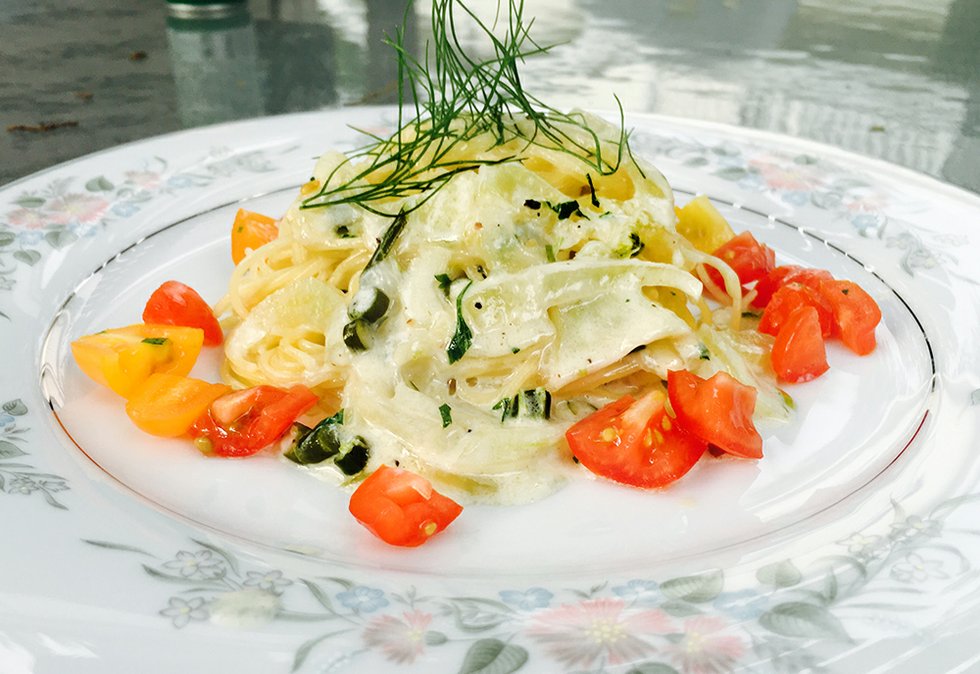
See those bright green, tall bulbs with the feathery fronds at the farmers market and grocery store produce section? It’s fennel, and if it’s not part of your repertoire of culinary ingredients, I encourage you to give it a try.
The flavor is often compared to anise and it smells very similar to licorice. If you’re not a fan of black licorice, don’t worry. The taste becomes much milder when cooked, offering a sweet and earthy element to a dish.
The whole plant can be used, even the seeds, and is prepared as a vegetable or used as an herb. It’s loaded with fiber, vitamins C and B-6, potassium, folate, and phytonutrients so it doesn’t just offer flavor, it packs a nutritious punch. Some cultures even eat raw fennel after a meal to aid digestion and cleanse the palate.
The fronds, the bulb, and the stalk in between
The thicker bulb of the plant generally is the main part used in most dishes. But the feathery leaves can be put to good use as well. I like to separate the fronds from the stalk and use them as an herb or garnish. Their flavor is more subtle than the bulb and the delicate leaves add a beautiful pop of color to finish a dish.
The fronds can be chopped up and added to a salad, used in pesto, tea, stock, or layered under meat or seafood.
The stalk in between is sort of a grey area for me. Though very aromatic, they’re quite woody (even the more tender bulb is rather fibrous and must be sliced very thin when eaten raw). I tend to save the stalks for soups or stock. You could also treat them like a bay leaf, and use large pieces to flavor a dish while cooking, then discarding them.
Raw vs. cooked and the ins and outs
Raw fennel is fresh and crunchy, akin to celery in texture, but with a distinct anise-like flavor. In salads it’s often paired with citrus fruit or apple, and dresses up nicely tossed with vinaigrette. In lieu of a traditional green salad, it’s lovely with roasted beets and sweet potatoes, or crisp cucumber and mint.
It is very important to slice raw fennel bulb almost paper thin or shaved as it can be tough to chew otherwise. I like to use my mandolin for this or my shredding attachment on my food processor. I also like to marinate it for a few hours or overnight when I prepare ahead of time. It’s not necessary but definitely helps to mellow the texture a bit.
Cooked fennel works wonders in a dish. The addition of fennel to a humble creamy bowl of tomato soup takes it from wow to wowza. It holds up well in the roasting pan along side of potatoes, carrots and other hearty vegetables. It can be sauteed, grilled, braised. It pairs very well with seafood—fish baked in a pan of roasted fennel, onions and tomatoes is a revelation. And it especially plays well in creamy sauces or dishes such as gratins.
One of my newest discoveries is to caramelize them! Just as you would onions, simply slice the bulb, removing the core, then cook over medium heat in a saute pan with a little oil, salt and pepper. As the fennel begins to brown, reduce heat a little and stir often. If the pan begins to dry, a little water can be added to assure they do not stick. Use them any place you would caramelized onions for a different twist to your dish.

fresh finocchio, florence fennel bulb isolated on white backgrou
fresh finocchio, florence fennel bulb isolated on white background
Fennel Cream Sauce
I used garlic scapes in this recipe because they are available now at the market but regular garlic or shallots can be used. Use this sauce to serve over pasta, fish or shellfish, chicken, or veggies.
2 Tbsp. olive oil
2 garlic scapes, finely chopped
1 cup fennel bulb, trimmed and finely chopped. Set aside fronds
1 Tbsp. butter
1 Tbsp. flour
1 cup stock (vegetable, chicken, or seafood)
1 cup heavy cream
¼ cup fresh parsley, chopped
Salt and pepper to taste
In a large sauté pan, heat oil over medium. Add garlic and fennel. Cook until softened, approx. 5 minutes. Add butter and let melt. Stir in flour to form a roux. Allow roux to cook out around 3 minutes, then stir in stock gradually, using a wooden spoon to release any bits in the bottom.
Bring to a gentle boil and let reduce by almost half. Add cream, again bringing to a gentle boil, reduce by a third. Stir in parsley and adjust seasoning.
Related: It’s strawberry season: Go get ’em!




